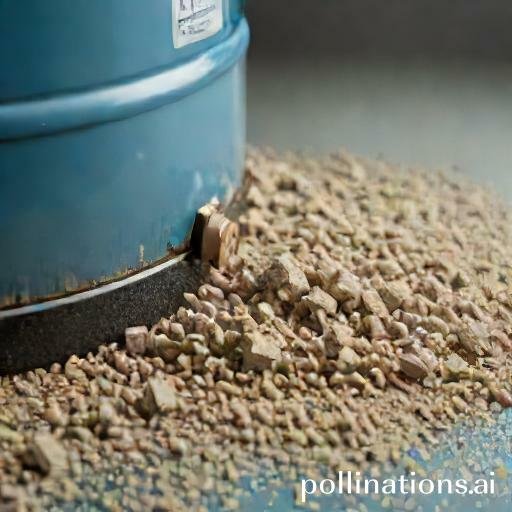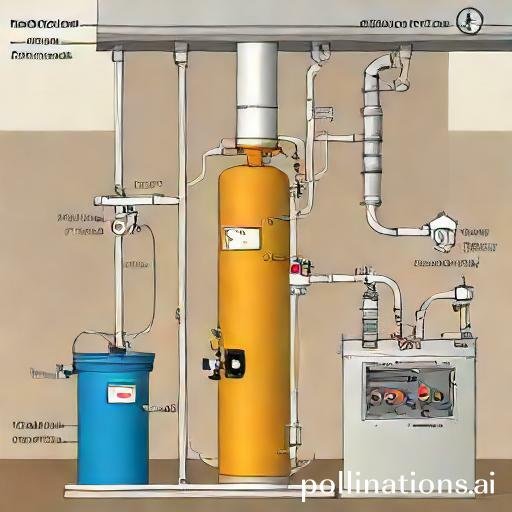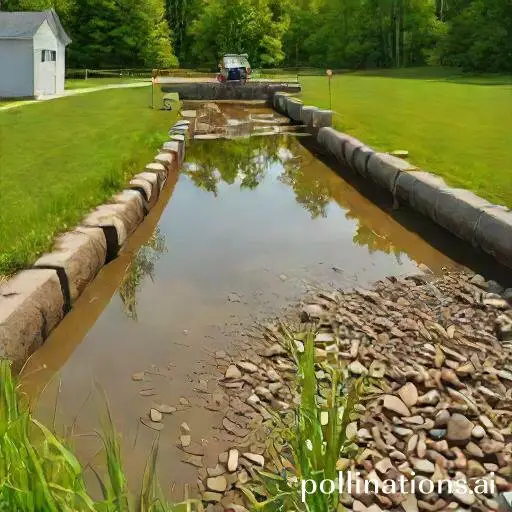
II. Regular maintenance, such as flushing the tank and installing a sediment filter, can prevent sediment accumulation and extend the life of the water heater.
III. Water heater scale prevention involves using chemical treatments or electronic devices to prevent mineral buildup, which can also improve efficiency and reduce energy costs.
Sediment removal and water heater scale prevention are crucial for maintaining the efficiency and longevity of your water heater. Over time, sediment can accumulate in the tank, reducing its heating capacity and causing potential damage.
By implementing proper sediment removal techniques, you can ensure that your water heater operates at its optimal level. Additionally, preventing scale buildup is essential to avoid corrosion and improve the overall performance of your water heater.
In this article, we will traverse effective methods for sediment removal and scale prevention, enabling you to prolong the lifespan of your water heater and maintain a reliable supply of hot water.
Common Causes of Sediment and Scale Buildup in Water Heaters
1. Hard Water
One of the primary causes of sediment and scale buildup in water heaters is the presence of hard water. Hard water contains high levels of minerals such as calcium and magnesium. When the water is heated, these minerals can precipitate and form sediment or scale. Over time, this buildup can reduce the efficiency of the water heater and lead to various issues.
For example, sediment can accumulate at the bottom of the tank, causing it to become less effective in heating the water. This can result in longer heating times and increased energy consumption. Scale, nonetheless, can form on the heating elements or inside the pipes, restricting water flow and potentially causing damage.
Regular maintenance and the use of water softeners or descaling agents can help mitigate the effects of hard water and minimize sediment and scale buildup.
2. Lack of Maintenance
Another common cause of sediment and scale buildup in water heaters is a lack of maintenance. Without proper care and regular flushing, sediment can accumulate in the tank over time. This is especially true for areas with hard water.
Regular maintenance involves draining the tank to remove any accumulated sediment. Flushing the tank once or twice a year can help prevent buildup and maintain the efficiency of the water heater. Additionally, checking and replacing the sacrificial anode rod, which protects the tank from corrosion, is essential to prolonging the lifespan of the water heater.
3. Aging Water Heaters
As water heaters age, they become more susceptible to sediment and scale buildup. Over time, the accumulation of minerals and debris can lead to decreased performance and efficiency.
If your water heater is old and experiencing frequent sediment or scale issues, it may be time to consider replacing it. A new water heater with modern features and improved efficiency can help reduce sediment buildup and provide better heating performance. Regular maintenance should still be performed to prevent future issues.
4. High Water Pressure
High water pressure can also contribute to sediment and scale buildup in water heaters. When the pressure is too high, it can cause turbulence and agitation within the tank, leading to the dislodging of sediment and scale particles.
Installing a pressure regulator can help control the water pressure and minimize the risk of buildup. Regular maintenance and flushing are still necessary to remove any sediment or scale that may have accumulated despite the regulated pressure.
| Cause | Effects |
|---|---|
| Hard Water | Reduced efficiency, longer heating times, increased energy consumption, restricted water flow |
| Lack of Maintenance | Accumulation of sediment, decreased heating efficiency, potential damage |
| Aging Water Heaters | Decreased performance, reduced efficiency |
| High Water Pressure | Turbulence, agitation, dislodging of sediment and scale particles |
Consequences of Sediment and Scale Buildup in Water Heaters
In the realm of maintaining the efficiency and longevity of your water heater, it is crucial to understand the consequences of sediment and scale buildup. This section explores the various impacts of these issues and provides valuable insights to help you address them effectively.
1. Reduced Energy Efficiency
One of the primary consequences of sediment and scale buildup in water heaters is a significant reduction in energy efficiency. As these deposits accumulate over time, they act as insulators, preventing the efficient transfer of heat from the heating element to the water. This inefficiency results in higher energy consumption and increased utility bills.
2. Increased Energy Costs
Building upon the reduced energy efficiency, sediment and scale buildup ultimately lead to increased energy costs. As your water heater works harder to compensate for the insulation caused by these deposits, it consumes more energy to heat the same amount of water. This unnecessary energy usage can significantly impact your monthly expenses.
3. Decreased Water Heater Lifespan
Sediment and scale buildup not only hinder energy efficiency but also contribute to the premature deterioration of your water heater. The accumulation of these deposits can cause corrosion and damage to the internal components, leading to a decreased lifespan of the unit. Regular maintenance and addressing buildup issues promptly can help extend the longevity of your water heater.
4. Risk of Water Contamination
Another critical consequence of sediment and scale buildup in water heaters is the potential risk of water contamination. As these deposits accumulate, they create an ideal breeding ground for bacteria and other harmful microorganisms. Contaminated water poses health risks, and it is essential to address sediment and scale buildup to ensure the safety of your water supply.
Methods of Sediment Removal and Scale Prevention in Water Heaters
Sediment buildup and scale formation are common issues in water heaters that can lead to reduced efficiency and potentially damage the unit over time. To ensure optimal performance and prolong the lifespan of your water heater, imperative to employ effective methods of sediment removal and scale prevention. This section will outline various techniques to address these concerns and maintain the quality of your water heater.
1. Flushing the Water Heater
Flushing the water heater is a simple yet essential step in sediment removal. By draining the tank and removing accumulated sediment, you can prevent clogs and improve the efficiency of your water heater. It is recommended to flush the tank at least once a year or as per the manufacturer’s guidelines.
2. Installing a Water Softener
Hard water contains minerals that can contribute to scale formation in water heaters. Installing a water softener helps mitigate this issue by removing these minerals, reducing the likelihood of scale buildup. It is an effective long-term solution for scale prevention.
3. Using a Descaler Solution
If scale has already formed in your water heater, using a descaler solution can help break down and remove the buildup. Follow the instructions provided by the manufacturer to ensure safe and effective descaling. Regular descaling can help restore the efficiency of your water heater.
4. Installing a Sediment Filter
A sediment filter can be installed in the water supply line to trap sediment particles and prevent them from entering the water heater. This filter helps reduce the amount of sediment that accumulates in the tank, minimizing the need for frequent flushing and improving overall system performance.
5. Regular Maintenance
Regular maintenance is crucial for the optimal functioning of any appliance, including water heaters. This includes inspecting the unit for any signs of leakage or damage, checking the temperature and pressure relief valves, and ensuring proper insulation. By acknowledging any issues promptly and conducting routine maintenance, you can prevent sediment buildup and scale formation.

DIY vs Professional Methods of Sediment Removal and Scale Prevention
1. Pros and Cons of DIY Methods
In regard to removing sediment and preventing scale buildup, many individuals consider tackling the task themselves. Meanwhile DIY methods may seem cost-effective and convenient, it is crucial to weigh the pros and cons before making a decision.
- Pros: DIY methods allow for immediate action and can be done at any time that suits your schedule. They also give you a sense of accomplishment and control over the process.
- Cons: DIY methods often lack the expertise and specialized equipment that professionals possess. This can lead to incomplete removal of sediment and inadequate scale prevention. Additionally, DIY methods may not address the root cause of the issue, resulting in recurring problems.
2. Benefits of Hiring a Professional
During DIY methods have their advantages, hiring a professional for sediment removal and scale prevention offers several benefits that cannot be overlooked.
- Expertise: Professionals have extensive knowledge and experience in dealing with sediment and scale issues. They can accurately assess the situation, provide customized solutions, and ensure thorough removal and prevention.
- Specialized Equipment: Professionals utilize advanced equipment specifically designed for sediment removal and scale prevention. This ensures efficient and effective results that DIY methods may struggle to achieve.
- Long-Term Solutions: Hiring a professional guarantees long-term solutions. They not only address the immediate problem but also identify and rectify the underlying causes, preventing future sediment buildup and scale formation.
3. Cost Comparison
Meanwhile cost is an important factor to consider, it is essential to evaluate the long-term implications and benefits when comparing DIY methods to professional services.
| DIY Methods | Professional Services |
|---|---|
| Initial Cost: DIY methods may seem more cost-effective initially as they involve purchasing products or tools. Nonetheless, recurring issues may lead to additional expenses. | Professional Fee: Hiring a professional may have a higher upfront cost, but it offers long-term value and eliminates the need for repeated attempts or potential damage caused by DIY methods. |
| Time and Effort: DIY methods require your time and effort, which might not be feasible for everyone. Additionally, if the problem persists, it may consume even more time and effort. | Convenience: Hiring professionals saves you time and effort. They handle the entire process, allowing you to focus on other priorities. |

Best practices for preventing sediment and scale buildup in water heaters
Water heaters play a crucial role in our daily lives by providing us with hot water for various purposes. Notwithstanding, over time, sediment and scale can accumulate inside the water heater, leading to reduced efficiency and potential damage. To ensure the longevity and optimal performance of your water heater, it is essential to follow these best practices:
1. Regular maintenance schedule
Creating a regular maintenance schedule is vital for preventing sediment and scale buildup in your water heater. This includes draining and flushing the tank to remove any accumulated debris. By performing this task at least once a year, you can significantly reduce the risk of sediment buildup.
2. Monitoring water quality
Monitoring the quality of the water entering your water heater is crucial. Hard water, which contains high levels of minerals such as calcium and magnesium, is more likely to contribute to sediment and scale buildup. Consider using a water testing kit to check the water hardness and take appropriate measures if necessary.
3. Adjusting water pressure
High water pressure can accelerate sediment and scale buildup in your water heater. It is recommended to adjust the water pressure to a moderate level to minimize the risk. Consult a professional plumber if you need assistance in discerning the ideal water pressure for your specific water heater model.
4. Installing a water softener or descaler
To address the issue of hard water and prevent sediment and scale buildup, installing a water softener or descaler can be highly beneficial. These devices work by removing or neutralizing the minerals responsible for the buildup, ensuring the longevity and efficiency of your water heater.
5. Flushing the water heater annually
Regularly flushing your water heater is an effective way to remove accumulated sediment and scale. This process involves draining the tank completely and allowing clean water to flow through, flushing out any debris. It is recommended to perform this task at least once a year to maintain optimal performance.
| Best Practices | Benefits |
|---|---|
| Regular maintenance schedule | Reduces risk of sediment buildup |
| Monitoring water quality | Identifies hard water issues |
| Adjusting water pressure | Prevents accelerated buildup |
| Installing water softener or descaler | Addresses hard water problems |
| Flushing the water heater annually | Removes accumulated debris |
Bottom Line
Keeping sediment and scale buildup under control is crucial for maintaining the efficiency and longevity of your water heater. Regular maintenance and flushing can help prevent sediment accumulation, during using a water softener or descaler can help prevent scale buildup. Neglecting these tasks can lead to decreased efficiency, higher energy bills, and even premature failure of your water heater. So, make sure to stay on top of sediment removal and scale prevention to ensure your water heater continues to provide reliable hot water for years to come.
Remember, prevention is key relating to sediment and scale buildup in your water heater. By taking proactive steps to keep your system clean and well-maintained, you can avoid costly repairs and replacements down the line. So, don’t wait until it’s too late – start taking care of your water heater today!
Read More:
1. Sediment Removal Frequency For Industrial Water Heaters
2. Sediment Impact On Water Heater Valve Functionality










